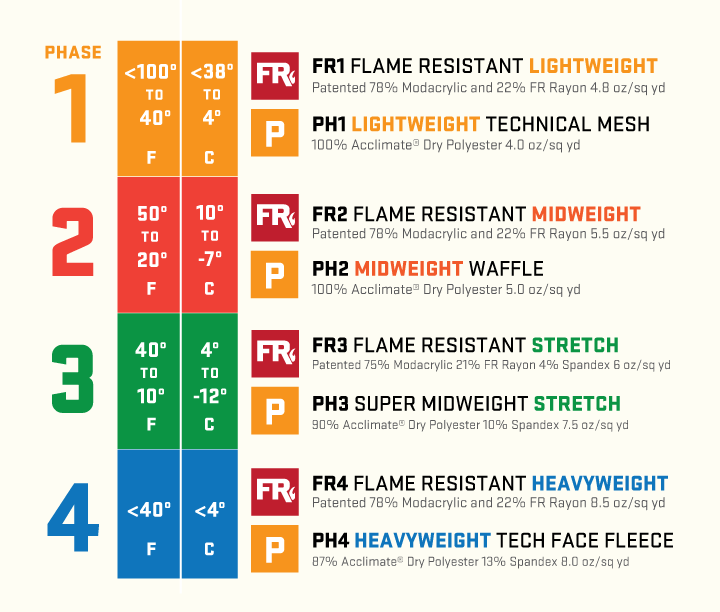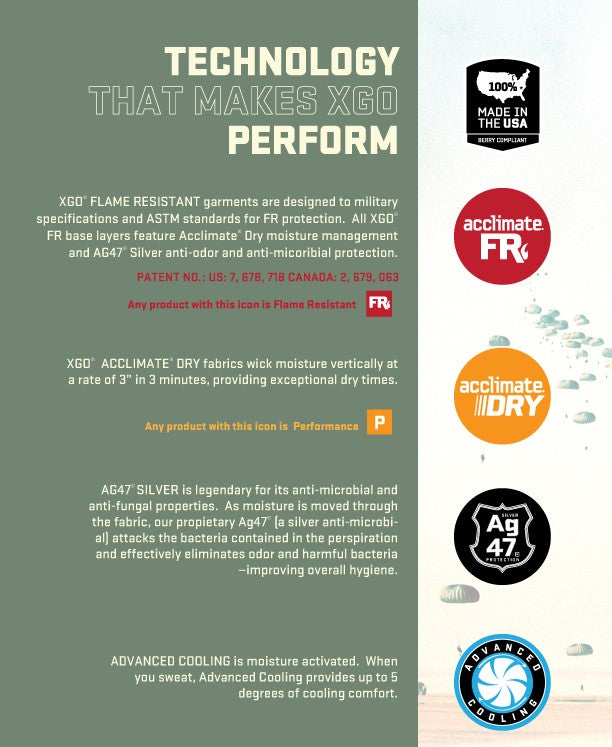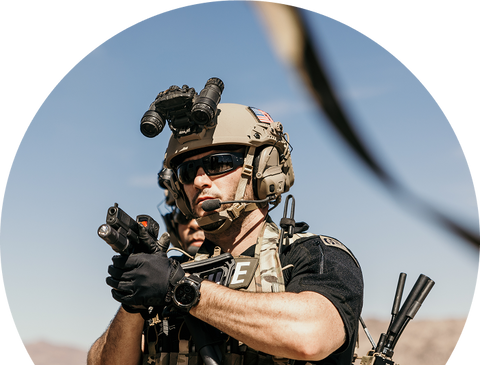XGO Layering System
Guide
Choosing the right layers is tricky but vital. Our layering guide will help you make the right choice, every time.
LAYERING BASICS
XGO doesn't just make base layers, we develop systems to help focus more on the mission at that, be it in theater or the field, and less on your gear. One of the first brands to introduce an engineered system of next-to-skin layers designed to be worn as standalone pieces or as part of a layering system, we took into account various environments and barriers that could eliminate comfort and attention. We take all of this to mind when we develop our garments. Our garments are designed with the most advanced tech, fabrics, designs and construction in order to standup to worst situations and last.
A good layering system or strategy needs to take into account a number of variables like: weather, season, environment/terrain, activity level and how your body regulates. Take into account the factors above and use the chart below to help you determine the types of layers that best meet your needs. The following information is here to help you make the most informed choices when purchasing your XGO layers. Keep in mind that a lot of these decisions should be based off your personal preference and activity level....you are the best source of information for your own body!
BUILT TO LAST
Your base layer is the heart of your layering system. As your next-to-skin layer...comfort, function and fit are crucial. Keep in mind that this layer is always on, hot or cold. One of the biggest factors that needs to be considered when looking at new base layer is fabric type. At XGO, we offer two main types, performance and flame retardant. Our performance layers consist of polyester or a polyester/spandex blend knits. Our FR (flame retardant) layers are constructed of our patented no melt, no drip modacrylic/fr rayon blend knit. Our FR property is inherent to the fibers and yarn, not a "treatment," meaning it will never wash or wear out. Protection for the life of the fabric.
All of our fabrics are measured by oz/sq. yd (ounces per square yard). This is a measurement of base fabric weight, the higher the number the heavier the fabric. In each type, performance and flame retardant, we have different constructions for different phases. Provided below are both performance and flame retardant phase charts.
All of our fabrics/garments, performance and flame retardant, have our proprietary high-performance Acclimate Dry moisture management (wicking & drying) and Ag47 anti-microbial/anti-odor. So, when choosing a next-to-skin layer, make sure to research the fabric before purchasing.
PERFORMANCE PHASE CHART
XGO "Phase" system represents fabric weight ranging from lightweight to heavyweight

Temperature Range Guide
Use the guide below for your base layer needs based off the conditions you may find yourself in.
75° - 100°F
When it comes to hot environments your main concentration should be: breathability and cooling the body as quickly and efficiently as possible. The products that we offer for this temp range are made of thin/light fabric and excel at moisture wicking, quick drying and air movement. Phase 1 is ideal for hot weather terrains. Keep your clothing light with a focus on moisture management and breathability.
10° - 40°F
This is the environment with the most unpredictable conditions. You can encounter elements like rain, sleet, or snow. Your layering system will need to be more intensive and based off your expected conditions. The addition of insulating base layer with a mid-layer will help with heat retention but, again...personal preference depending on your activity level. We recommend, during these conditions, your next-to-skin layer being Phase 3, your mid-layer being Phase 1 or Phase 2, then your outer layer. Heat management is key, so check the weather, determine your activity level, and plan accordingly.
50° - 75°F
This is the environment where it starts off cool but gets warmer as the day goes on. In this in-between temp you may need a next-to-skin base layer and a nice mid-layer. We recommend your base-layer being Phase 1 with your Phase 2 over top, then an outer layer if you choose. This will ensure that during the colder temps your staying warm but when it turns warmer you can take your Phase 2 off and be okay with Phase 1. Remember to always factor in your activity level, and plan accordingly.
<30°F
This is the coldest of the cold environments where staying warm is vital. You shouldn't have to sacrifice comfort thought. Insulation pieces are the most crucial additions, as they trap the heat in making the below freezing temps tolerable. A good strategy is a base layer, multiple mid-layers, and outer layers. We recommend Phase 4 or Phase 5 as your next-to-skin base layer, Phase 2 mid-layer one, Phase 1 mid-layer two and then your outer layer. Sounds like a lot but heat retention is the number one priority with this layering system. Stay warm, stay alive.
DIFFERENCE IN THE DETAILS
All our garments are designed with the end user in mind. We listen to the "bottom-end" feedback to help design better garments. Everything we do is engineered with Clean Seam next-to-skin flat seaming construction for comfort to the wearer. On our tops we roll our shoulders to remove the seam off the top of the shoulder, combating the possibility of irritation from friction between the shoulders and plate carriers/backpacks/vest/etc. Additionally, on all tops we add both an under arm gussets for increased mobility and breathability but also added length to the body of the garment to ensure they stay tucked in.









